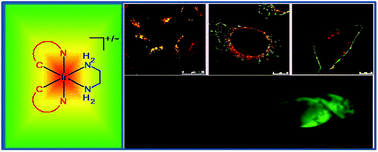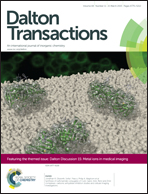Phosphorescent biscyclometallated iridium(iii) ethylenediamine complexes functionalised with polar ester or carboxylate groups as bioimaging and visualisation reagents†
Abstract
We report the synthesis, characterisation and photophysical properties of new phosphorescent biscyclometallated iridium(III) ethylenediamine (en) complexes functionalised with polar ester or carboxylate groups [Ir(N^C)2(en)]n(X) (n = +1, X = Cl−, HN^C = methyl 4-(2-pyridyl)benzoate Hppy-COOMe (1a), methyl 2-phenyl-4-quinolinecarboxylate Hpq-COOMe (2a); n = −1, X = Li+, HN^C = 4-(2-pyridyl)benzoate Hppy-COO− (1b), 2-phenyl-4-quinolinecarboxylate Hpq-COO− (2b)). In aqueous solutions, the carboxylate complexes 1b and 2b displayed emission quenching (ca. 7 and 74 fold, respectively) and lifetime shortening upon protonation, and their pKa values were determined to be 5.13 and 3.46, respectively. The pq complexes 2a and 2b exhibited hypsochromic shifts in their emission maxima and a significant increase in emission intensity (ca. 84 and 15 fold, respectively) upon nonspecific binding to the protein bovine serum albumin (BSA). Inductively coupled plasma-mass spectroscopy (ICP-MS) and laser-scanning confocal microscopy (LSCM) results revealed that the ester complexes 1a and 2a were efficiently internalised by the human cervix epithelioid carcinoma (HeLa) cells through energy-requiring pathways and subsequently localised in endosomes and mitochondria, respectively. They showed good biocompatibility in the dark, but became significantly cytotoxic upon photoirradiation due to the generation of singlet oxygen. In contrast, in aqueous solutions of physiological pH, the carboxylate complexes 1b and 2b existed as the anionic form and hardly entered cells due to limited membrane permeability, as evidenced by the intense emission surrounding the plasma membrane of the cells. They showed negligible cytotoxicity and the cell viability remained over 95% for an incubation period of 24 hours. In view of the low cytotoxicity and strongly emissive nature of the hydrophilic ppy-COO− complex 1b in an aqueous medium, the potential application of the complex as a visualisation reagent has been demonstrated using zebrafish (Danio rerio) as an animal model.

- This article is part of the themed collection: Dalton Discussion 15: Metal ions in medical imaging

 Please wait while we load your content...
Please wait while we load your content...